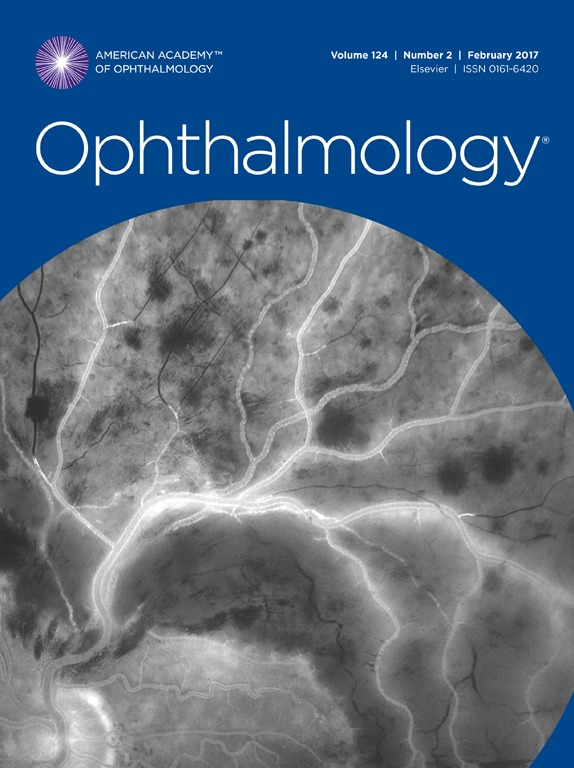Ocular Neovascular Conversion and Systemic Bleeding Complications in Patients with Age-Related Macular Degeneration on Anticoagulants
IF 13.1
1区 医学
Q1 OPHTHALMOLOGY
引用次数: 0
Abstract
Purpose
Conversion to neovascular disease in patients with non-neovascular age-related macular degeneration (AMD) initiated on direct oral anticoagulants (DOACs) compared with matched patients treated with warfarin.
Design
Retrospective cohort study.
Participants
The study included 20 300 patients and 13 387 patients with non-neovascular AMD initiated on DOACs or warfarin, respectively, before propensity score matching (PSM).
Methods
TriNetX was used to identify patients diagnosed with non-neovascular AMD stratified by treatment with DOACs or warfarin with at least 6 months of follow-up. Propensity score matching was performed to control for baseline demographics and medical comorbidities.
Main Outcome Measures
Relative risk (RR) of developing neovascular AMD, macular hemorrhage (MH), vitreous hemorrhage (VH), and requiring an ocular intervention (intravitreal anti-VEGF therapy or pars plana vitrectomy [PPV]) within 6 months and 1 year. Patients with chronic atrial fibrillation (AF) on anticoagulation were separately evaluated for the same measures within 5 years after initiating therapy.
Results
Treatment with warfarin was associated with a higher risk of developing neovascular AMD at 6 months (RR, 1.24, 95% confidence interval [CI], 1.12–1.39; P < 0.001) and 1 year (RR, 1.26, 95% CI, 1.14–1.40; P < 0.001) when compared with matched patients treated with DOACs. There was an increased risk of requiring intravitreal anti-VEGF therapy (6 months: RR, 1.30; 95% CI, 1.13–1.49; P < 0.001; 1 year: RR, 1.31, 95% CI, 0.72–2.05; P < 0.001) and PPV (6 months: RR, 2.13; 95% CI, 1.16–3.94; P = 0.01; 1 year: RR, 2.29, 95% CI, 1.30–4.05; P = 0.003). Among patients with AMD and AF treated with warfarin, there was an increased risk of ocular complications (neovascular AMD: RR, 1.25; 95% CI, 1.14–1.38; P < 0.001; MH: RR, 1.86; 95% CI, 1.47–2.35; P < 0.001; VH: RR, 2.22; 95% CI, 1.51–3.26; P < 0.001) and need for intravitreal anti-VEGF therapy (RR, 1.34; 95% CI, 1.18–1.52; P < 0.001) over an extended 5-year period. There was no significant difference in the development of major systemic hemorrhagic events between the 2 cohorts over 5 years.
Conclusions
Patients with non-neovascular AMD treated with warfarin were more likely to develop neovascular disease and require ocular intervention for hemorrhagic complications when compared with matched patients initiated on DOACs.
Financial Disclosure(s)
Proprietary or commercial disclosure may be found after the references.
使用 DOACs 或华法林的老年性视网膜病变患者眼部新生血管转换和全身出血并发症的风险。
目的:与接受华法林治疗的匹配患者相比,接受直接口服抗凝剂(DOAC)治疗的非新生血管性老年性黄斑变性(AMD)患者转为新生血管性疾病的情况:研究对象、参与者和/或对照组:该研究纳入了20300名患者和13387名患者,他们都是在倾向评分匹配(PSM)前开始使用DOAC或华法林治疗的非新血管性AMD患者:采用 TriNetX(美国马萨诸塞州剑桥市)来识别诊断为非血管性 AMD 的患者,并按照使用 DOACs 或华法林治疗且随访至少 6 个月进行分层。进行倾向评分匹配以控制基线人口统计学和医疗合并症:主要结局指标:6个月和1年内发生新生血管性AMD、黄斑出血(MH)、玻璃体出血(VH)以及需要眼部干预(玻璃体内抗血管内皮生长因子(VEGF)治疗或玻璃体旁切除术(PPV))的相对风险(RR)。对接受抗凝治疗的慢性心房颤动(房颤)患者在开始治疗后5年内的相同指标进行了单独评估:结果:接受华法林治疗的患者在六个月内罹患新生血管性黄斑变性的风险较高(RR,1.24, 95% CI, 1.12 - 1.39; PC结论:接受华法林治疗的非新生血管性黄斑变性患者在六个月内罹患新生血管性黄斑变性的风险较高:与接受 DOACs 治疗的匹配患者相比,接受华法林治疗的非新生血管性 AMD 患者更有可能罹患新生血管性疾病,并需要对出血性并发症进行眼科干预。
本文章由计算机程序翻译,如有差异,请以英文原文为准。
求助全文
约1分钟内获得全文
求助全文
来源期刊

Ophthalmology
医学-眼科学
CiteScore
22.30
自引率
3.60%
发文量
412
审稿时长
18 days
期刊介绍:
The journal Ophthalmology, from the American Academy of Ophthalmology, contributes to society by publishing research in clinical and basic science related to vision.It upholds excellence through unbiased peer-review, fostering innovation, promoting discovery, and encouraging lifelong learning.
 求助内容:
求助内容: 应助结果提醒方式:
应助结果提醒方式:


